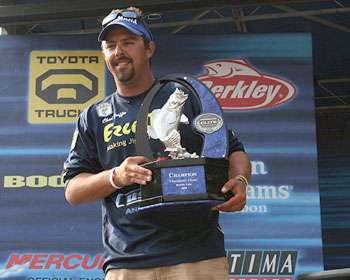
When Elite Series rookie Chad Griffin won the final regular season event of the 2009 season on Oneida Lake, he caught the attention of fans and fellow tournament competitors alike when said that he threw his topwater popper on 20-pound-test fluorocarbon line. While fluorocarbon is relatively new to bass fishing, any serious bass angler worth his salt knows that topwaters and fluorocarbon don't mix. Fluorocarbon sinks — topwater baits don't. So, what was behind Griffin's decision?
"There are several answers to this question," explains the Texas pro. "The first is that I was actually being a little lazy. I only brought four rods in the boat and the biggest line that I had was 20-pound fluorocarbon. I was scared that those giant smallmouths would break me off, so I decided to throw the Zell Pop on the heavy fluorocarbon."
Aside from the fact that Griffin threw the heavy line out of necessity, fluorocarbon possesses several qualities that make it a viable option in certain topwater applications.
"Yeah, I know that fluorocarbon line sinks and that it's not good with a lot of topwater baits," admits Griffin. "Ninety percent of the time when I'm fishing topwaters, I'm using monofilament line, but at Oneida, it didn't make a difference. In fact, it actually helped me." Because he was fishing large grass flats for wary smallmouth, long casts were critical to Griffin's success and with fluorocarbon, he could achieve the needed distance.
Line stretch, or lack of, also played into Griffin's decision to stick with fluorocarbon line. "When a big smallmouth comes up and hits the bait, the first thing it's going to do is jump and the second thing is to go straight down into the thick grass," he says. "Fluorocarbon seems to cut through the grass a lot better than monofilament and that allowed me to get those bass in the boat."
The speed Griffin worked his topwater also allowed him to use fluorocarbon. "I was working the popper really quickly, almost like someone would fish a crankbait," he explains. With a fast presentation, there was little time for his fluorocarbon to sink below the surface and affect the action of the lure. "In Texas, I throw soft plastic buzz frogs on fluorocarbon because I don't want any line stretch," he explains. "It's moving so fast that the line never really has a chance to sink."
Visibility was the third reason Griffin chose fluorocarbon line. Even though he was casting to schooling bass, Oneida's clear water made the fish wary of anything unnatural in the area. "I think the clear fluorocarbon actually made the bass more aggressive on my popper because they couldn't see the line," says Griffin.
The final reason that Griffin threw fluorocarbon came down to confidence. "I have so much confidence in the Seaguar fluorocarbon. With mono, I just didn't have any faith that I could get those big smallmouth in the boat once they hit because they would get buried in the grass."
The obvious question is why didn't Griffin use braided line? "I don't like braid. It tears up my rods, it tears up my reels. I just don't like it," he explains. "I've done a lot of experimenting with it and I just haven't found many applications where I would use it."
As a final tip to anglers thinking about giving fluorocarbon a chance with topwater baits, Griffin offers this: "You can put your rod tip in the air and then pop it a few times. That popping action gets the line out of the water and floating on the surface again."




